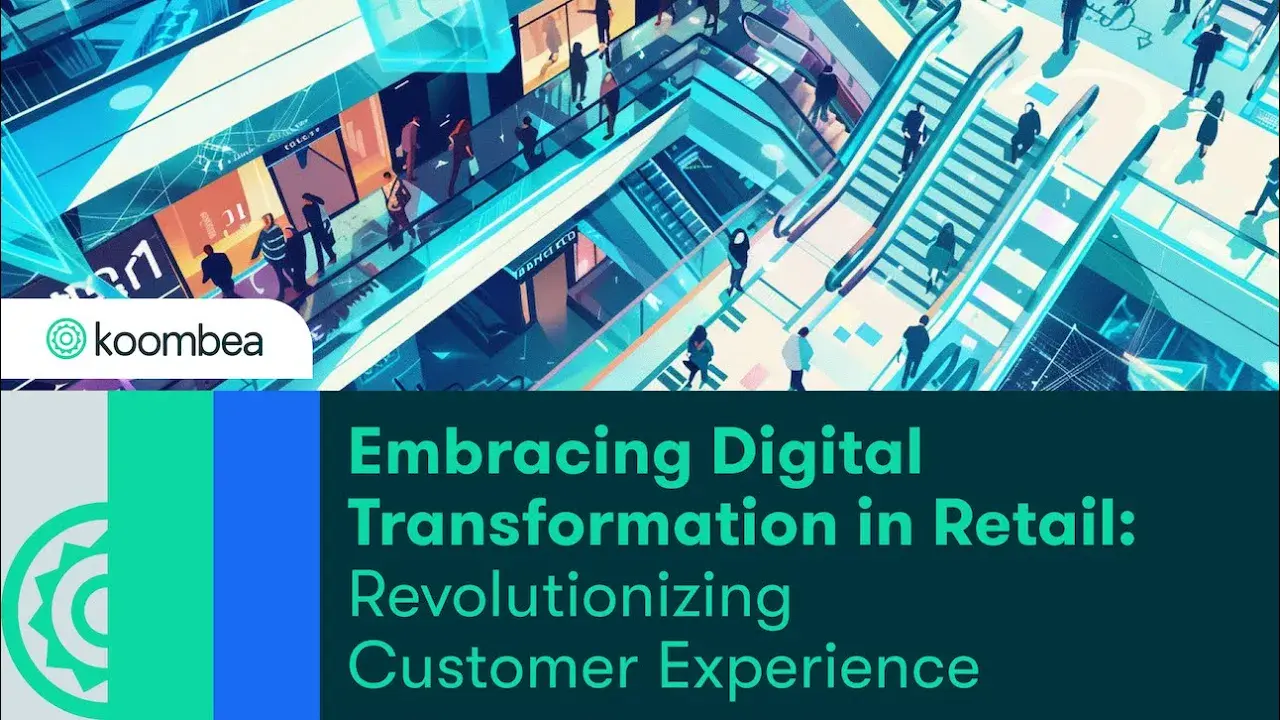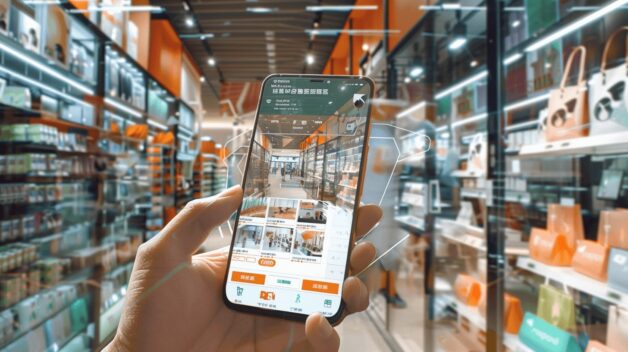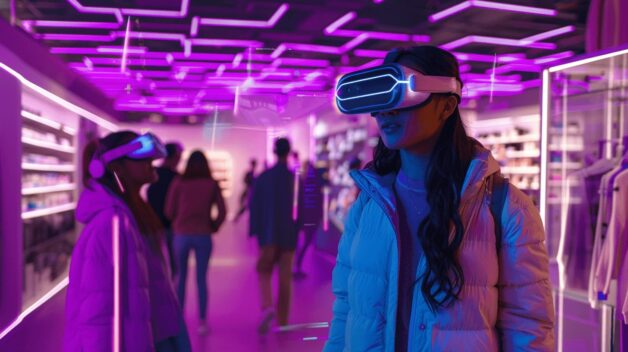
Digital transformation in retail is revolutionizing the industry, reshaping every aspect of how retail businesses operate and engage with customers. This digital transformation process is not just about adopting new technologies; it represents a fundamental shift in how retail companies think about and interact with their consumers. The retail industry is witnessing unparalleled efficiency and customer satisfaction through digital transformation.
From AI-enhanced personalized shopping experiences to smart inventory management, this digital revolution redefines customer interaction and streamlines retail operations, marking a significant digital transformation in the retail industry. As the industry evolves, embracing AI becomes a pivotal aspect of staying ahead in the competitive landscape.
This article delves into the real-world applications and benefits of digital transformation in retail, highlighting how digital transformation in retail is pivotal for future success and showcasing how online retailers leverage these technologies to stay competitive and meet the high demands of today’s consumers.
Key Takeaways from Digital Transformation in Retail
- AI is a critical driver in digital transformation, impacting the retail industry through digital transformation efforts, customer personalization, inventory management, and pricing strategies, with projections of the AI retail market reaching $27 billion by 2025.
- Retailers are achieving a seamless shopping experience through digital innovation, including headless commerce architectures and microservices, leading to improved client satisfaction and increased sales.
- Enhanced order fulfillment is a key benefit of retail digital transformation, with AI optimizing warehouse management and digital logistics, leading to a 30% reduction in operational costs.
Embracing AI in Retail: The Future is Now

Digital transformation trends reshape every facet of the shopping experience, placing retail at a significant turning point. The fundamental aspect of this revolution is artificial intelligence. (AI), a powerful force driving innovation and efficiency across retail businesses.
AI in retail can:
- Personalize customer experiences
- Optimize inventory and pricing strategies
- Improve demand forecasting
- Enhance supply chain management
- Streamline operations and reduce costs
AI is not just an option for retailers—it’s imperative for staying competitive in today’s market. The retail business’s commitment to leveraging digital technologies is evident in the surge of investment, marking AI’s emergence in retail, underscoring the importance of digital transformation in redefining the competitive edges of the retail industry. Projections indicate that the AI market in retail could reach $27 billion by 2025. Retail businesses recognize the profound impact that AI can have on enhancing customer engagement, streamlining retail operations, and, ultimately, cementing their position in the retail landscape.
AI-Driven Personalization
Personalization is the cornerstone of modern retailing, and AI is the architect. In this digital transformation era, leveraging customer data becomes a cornerstone for creating tailored experiences that resonate deeply with consumer preferences. By leveraging in-depth customer data, online retailers enhance the shopping experience with personalized marketing that resonates with each customer, predicting consumer behavior with remarkable accuracy and allowing for more effective inventory management. This approach improves the customer experience and promotes a more profound sense of customer loyalty. Here are some benefits of personalization in retail:
- 75% of consumers prefer retailers who recognize them by name and make recommendations based on past purchases
- Tailored marketing strategies increase engagement and conversion rates
- Personalization improves customer satisfaction and customer loyalty
- Providing customized recommendations to customers can result in higher average order values
- Personalization helps retailers stand out in a crowded market and differentiate their brands
Understanding consumer behavior through detailed data analytics is fundamental in driving the digital transformation efforts of businesses in the Retail Industry, enabling them to predict and meet the evolving needs of their customers. A Retail company can create a more personalized shopping experience by leveraging AI technology. AI is not only about crunching numbers; it’s about connecting with customers personally.
Through mobile apps, retailers use machine learning and data analytics to adapt online content and offer in real-time, creating a dynamic shopping environment that keeps customers returning for more. With AI-powered engines capable of boosting digital business profits by up to 15%, the financial incentives for personalizing customer experiences are as clear as they are compelling.
In this digital transformation era, leveraging customer data becomes essential for creating tailored experiences that deeply resonate with consumer preferences. By utilizing in-depth customer data, retailers are empowered to enhance the shopping experience with personalized marketing, predicting customer behavior with remarkable accuracy.
Augmented reality (AR) further pushes the boundaries of personalization in retail, allowing customers to see how products look in their real-life environment before making a purchase. This AR integration represents a significant leap in digital transformation strategies for enhancing the shopping experience.
AI in Inventory Management
Reliance on manual counting and educated guesses is becoming obsolete in inventory management. With AI stepping into play, retailers are equipped with sophisticated tools that allow them to predict demand accurately, thereby fostering an environment where efficient inventory management thrives—simultaneously cutting down on surplus stock and associated carrying costs. The pioneering role in this shift towards smart inventory solutions is played by machine learning algorithms that adeptly curtail excessive stock levels and product shortages.
The integration of AI technologies within the framework of inventory control brings a multitude of enhancements for retail operators, among which are:
- Strategic selection of superior suppliers who excel in product quality and expedited delivery
- Refinement of stock quantities aligned with distinct market requirements
- A marked reduction reaching up to 80% in situations where items run out of stock
These significant improvements attest to artificial intelligence’s pivotal influence over augmenting supply chain effectiveness.
AI in Pricing and Promotions
In the competitive retail arena, setting the right price can spell either triumph or disaster for a business. The advent of AI introduces cutting-edge, dynamic pricing tactics that enable retailers to:
- Dynamically modify prices according to market fluctuations and consumer inclinations
- Optimize profit margins
- Keep prices competitive while aligning with the preferences of target customers.
This flexibility optimizes profits and ensures keeping pace competitively in terms of pricing for specific customer demographics.
Retailers gain multiple advantages from employing AI-driven pricing strategies such as:
- Striking a balance between profitability and keeping customers satisfied
- Enhancing customer loyalty due to better value propositions
- Gaining insights into competitors’ actions allows swift responses to changes in the marketplace
- Preserving an advantageous position within their industry
- Increasing revenues by 5–10% and elevating profits up to 60% over a yearlong period
These perks underscore how artificial intelligence is revolutionizing retail practices concerning pricing and promotions.
Creating Seamless Omnichannel Experiences

The shopper’s journey now extends beyond the confines of the storefront. Today’s customers expect a shopping experience that seamlessly connects physical stores with online platforms, creating an integrated omnichannel presence. This is where digital transformation shines for online retailers, combining various customer touchpoints into a cohesive brand experience that enhances customer experience and customer loyalty.
Retail companies are making strides in this area, with digital technologies enabling real-time inventory management, with digital technologies enabling real-time inventory management and customer relationship management across channels. A retailer that integrated their online and offline customer data saw a 35% increase in online sales, a testament to the power of a well-executed digital transformation strategy in retail stores.
The goal of digital transformation in the retail industry is to create a seamless shopping experience, connecting physical stores with online platforms to ensure customers can move effortlessly between channels.
Headless Commerce Architecture
Headless commerce architecture, with its flexibility and agility, is revolutionizing eCommerce. By separating the front-end presentation layer from the back-end infrastructure, retailers can make changes and updates without disrupting the system. This architectural approach offers several benefits.
- Enhances the customer experience across digital channels
- Provides developers with the freedom to work with their preferred tools
- Leads to a 40% reduction in website loading times
- Increases conversion rates
However, headless commerce is not without its challenges. It introduces added complexity in managing systems and necessitates a skilled developer team to navigate these waters. Despite these hurdles, the benefits of headless commerce include:
- A consistent customer experience across multiple channels
- The capacity to swiftly adjust to the changing market demands
- Increased flexibility and scalability
- Improved performance and speed
- Enhanced personalization and customization options
These advantages make headless commerce attractive for retailers on their digital transformation journey.
Microservices and Modular Architectures
In the dynamic world of retail, quickly responding to shifts in the market is essential. Retailers can achieve this through microservices and modular structures by moving away from old-fashioned monolithic systems, allowing for:
- Expedited introduction of novel features
- Streamlined operations across business functions
- Autonomous development, deployment, and governance of individual elements
- Enhanced robustness within their systems
- Diminished risks during updates
For retailers who incorporate microservices into their mobile apps:
- Updates can be rolled out 60% quicker compared to older architectures
- There’s an ability to satisfy consumers’ ever-evolving desires
- They preserve a strong position in today’s digital commercial landscape
Such agility and rapid adaptability are critical for triumphing in the current state of the retail sector, notably for enterprises engaged in retail commerce.
Enhancing Order Fulfillment with Digital Transformation

In the era of eCommerce, the ability to fulfill orders effectively is critical for thriving businesses in the Retail Industry. Digital transformation catalyzes this enhancement, significantly improving supply chain efficiency from warehouse management to transport cost reduction and faster deliveries. Retailers are leveraging digital technologies to fine-tune their supply chains and enhance operational efficiency, ultimately increasing efficiency and customer satisfaction.
Retailers use digital platforms to work with carriers to ship goods more economically and expediently. Transportation management systems must be integrated seamlessly with overall supply chain operations as part of this digital shift. Such integration can lead to a 30% decrease in logistics-related expenses thanks largely to optimizations made possible through better route planning and warehouse automation.
AI in Order Fulfillment
AI is revolutionizing how traditional retailers fulfill orders by introducing automation and smart data analytics into warehouses. Some of the benefits of AI in warehousing include:
- Streamlining operations
- Minimizing human error
- Accelerating workflows
- Improving order processing efficiency by up to 70%
- Reducing delivery times
- Boosting customer satisfaction
The efficiency gains from AI in warehousing are significant and can significantly improve the overall fulfillment process for retailers.
These AI-driven systems don’t just move products faster; they ensure that only the best quality items reach the customer. Computer vision technology used for object recognition and quality control in warehouses is a game-changer, guaranteeing a consistent level of product quality and mitigating the risk of returns due to defects.
Real-Time Inventory Tracking
At the heart of retail logistics, including managing warehouses, lies the ability to track inventory in real-time. Retailers can efficiently manage their stock levels and guarantee that products are always available for customers by employing artificial intelligence (AI) to analyze customer data and predict future trends. The importance of effective inventory management cannot be overstated. It is crucial to minimize inefficiencies that can impede order processing and fulfillment.
The implementation of real-time inventory tracking systems brings numerous advantages, such as:
- A reduction in stock inaccuracies by up to 25%, greatly enhancing accuracy in how inventories are managed
- Equipping retailers with a detailed insight into the movement of their stocks
- Keeping operations streamlined
- Guaranteeing that regardless of whether they shop digitally or within physical stores, customers will find what they need without inconvenience.
Building In-House Tech Expertise
With the retail industry’s ongoing embrace of digital transformation, the importance of in-house tech expertise becomes increasingly apparent. Retailers invest heavily in building engineers and data scientists teams to innovate and support their digital strategies. For instance, Home Depot’s commitment to hiring 1,000 technology professionals underscores the importance of developing an internal talent pool to drive digital innovation and protect intellectual property.
Moving towards headless commerce and adopting open-source AI platforms for inventory management are just some areas where in-house tech expertise is crucial. Not only does it improve delivery performance and innovation capability, but investing in tech expertise can also reduce IT costs by 20%, highlighting the value of nurturing a tech-savvy workforce.
Talent Acquisition Strategies
Talent acquisition strategies play a pivotal role in pursuing in-house tech expertise. Retailers must navigate the competitive tech recruitment landscape with data-driven approaches and compelling compensation packages beyond salary. Investing in cutting-edge HR software and making a solid impression at tech industry events are effective ways to draw in the best talent.
A strong employer brand is another powerful tool in attracting tech professionals. It can reduce hiring costs by up to 50% and decrease turnover rates, making it an essential component of any successful recruitment strategy. Involving current tech team members in the hiring process ensures compatibility and helps define precise job specifications, fostering a cohesive and innovative team environment.
Employee Training and Development
In a tech-driven retail transformation, employee training and development serve as the lifeblood. Continuous learning opportunities increase employee productivity by 37% and improve job satisfaction and loyalty. Retail giants like Walmart have recognized this and are incorporating VR training platforms into employee development programs.
Career development programs offer employees the following:
- A clear pathway for growth within the company
- Attracting and retaining top talent
- Structured training initiatives to empower employees
- Ensuring the workforce is skilled and ready to face the challenges of a digitally evolving retail landscape.
Augmented Reality and Virtual Reality in Retail

Retail increasingly adopts augmented reality (AR) to create and pursue immersive and engaging shopping experiences. These digital technologies enhance and revolutionize the customer experience by offering unique ways to interact with products and brands. With over 20% of retailers planning to introduce augmented reality technology within the next year, it’s clear that the future of shopping is here.
The impact of AR and VR on customer engagement is significant, with these technologies potentially boosting engagement by up to 30%. From Alibaba’s VR shopping platform to IKEA’s AR furniture visualization app, retailers find innovative ways to blend digital and physical realities, leading to higher conversion rates and average order values.
In augmented and virtual reality, retailers like Zara and Nike are setting benchmarks for immersive customer experiences. Zara’s use of augmented reality in stores allows customers to see models wearing selected clothing items through smartphones, bridging the gap between online browsing and in-store shopping. Nike’s House of Innovation takes interaction with consumers to another level with VR experiences that allow customers to design and personalize products in a virtual space. These advancements underscore the growing importance of AR and VR in creating interactive and personalized shopping journeys.
AR in Product Visualization
Virtual try-on technology, enabled by augmented reality, opens a new dimension in product visualization, letting customers see how products look on or in their homes before purchasing. Retailers like H&M and Sephora use AR to enhance the in-store and mobile app shopping experience, allowing customers to virtually try on clothes or makeup. This interaction increases customer confidence in purchasing decisions and reduces the likelihood of returns.
Furniture retailers such as Crate Barrel and IKEA have also embraced augmented reality, providing customers with tools to visualize how products would fit into their living spaces. The ability to see a 3D model of a product in one’s environment is a powerful tool for enhancing customer interaction and satisfaction.
VR in Immersive Shopping Experiences
Virtual Reality takes immersive shopping experiences to unprecedented heights by plunging customers into a comprehensive simulated setting. Brands like TOMS are harnessing VR technology to forge connections with their clientele by showcasing the company’s narrative and core values. Meanwhile, outdoor brands such as Merrell and The North Face use this technology to recreate natural environments that highlight specific attributes of their products, fostering deep engagement through unforgettable interactions with the brand.
Enhancing customization in shopping, virtual stylists and shared VR spaces provide consumers with personalized guidance and enable them to shop alongside others within a virtual realm. Leading retailers, including BMW, Audi, and Nike, have adopted VR so that clients can tailor products according to their preferences and immerse themselves in comprehensive product stories—demonstrating the expansive capabilities of Virtual Reality within retail.
Case Studies: Successful Digital Transformation in Retail
Studies of significant retailers that have embraced these innovations provide the most transparent view of how digital transformation can impact retail. The triumphs recorded show that investing thoughtfully in technology leads to marked enhancements in both business outcomes and shareholder value. Retailers with a comprehensive understanding of digital principles tend to experience more significant returns on shareholder investments, underscoring the critical nature of having an extensive digital strategy.
Including aspects specific to retail, digital transformation equips businesses with the agility necessary to swiftly bring new digital services and products to market while accelerating their efforts toward building internal proprietary competitive advantages. This capacity for rapid technological evolution is increasingly becoming a pivotal element behind what makes contemporary retail enterprises successful.
Example 1: Sephora
Sephora exemplifies the transformative power of digital innovation in retail, mainly through its use of augmented reality for personalized shopping experiences. Its Virtual Artist app and in-store technologies allow customers to try on makeup virtually, blending physical and digital realms to enhance customer engagement and satisfaction. This digital approach not only caters to the personalized needs of shoppers but also drives higher conversion rates and loyalty by offering a unique and interactive shopping experience. Sephora’s commitment to digital transformation highlights the importance of personalized, technology-driven customer interactions in today’s retail landscape.
Example 2: Walmart
Walmart’s digital transformation journey is marked by its innovative use of technology to streamline operations and improve customer service. The retailer’s investment in the Alphabot system for order fulfillment and its partnership with Google for voice-activated shopping are prime examples of its strategy. Alphabots automate online orders’ sorting, packing, and delivery, significantly reducing processing times. Meanwhile, voice shopping via Google Assistant enhances convenience for customers, simplifying the shopping process with simple voice commands. These initiatives demonstrate Walmart’s foresight in adopting cutting-edge technology to meet evolving consumer expectations and maintain its competitive edge.
Digital Transformation’s Impact on Employment
As retail evolves through digital transformation, the impact on employment is profound and multifaceted. Innovative technologies streamline operations, enhance customer experiences, and redefine workforce dynamics. Introducing AI, AR, VR, and other digital tools demands a new cadre of tech-savvy professionals, including data scientists, AI specialists, and digital marketing experts.
Retail giants like Walmart are at the forefront of this shift, demonstrating a significant commitment to building in-house tech expertise. The company’s strategic investment in technology and talent underscores the critical role of digital skills in the future of retail. By fostering a culture of innovation and continuous learning, retailers can leverage digital transformation for operational efficiency to create a seamless shopping experience and to serve as a catalyst for employment growth and professional development in the digital age.
As part of the digital transformation in the retail industry, augmented reality applications are becoming more prevalent, offering unique ways for customers to engage with brands and products online.
Mobile apps are transforming the retail landscape by providing consumers with personalized shopping experiences at their fingertips, further driving the digital transformation agenda in retail. This evolution highlights the pivotal role of technology in understanding and predicting customer behavior and directly engaging customers through their preferred digital channels. As digital transformation continues to unfold, the ability of retailers to adapt and invest in their employees will be a key determinant of their success in the competitive market.
Summary
Digital transformation in retail is not just a trend—it is an ongoing journey shaping the future of how we shop and interact with brands. Retailers who embrace digital technologies, including AI, omnichannel strategies, and AR/VR, are redefining the customer experience, enhancing operational efficiency, and setting new benchmarks for the industry. The case studies of Walmart and Home Depot underscore the tangible benefits of these investments, from improved customer engagement to significant growth in sales and revenue.
Augmented reality is a key technology in the retail digital transformation journey, bridging the gap between digital convenience and the tactile feedback of in-store shopping.
As explored throughout this blog post, the key to successful digital transformation lies in the ability of a retail business to innovate, adapt, and personalize the shopping journey. By building in-house tech expertise and leveraging cutting-edge digital tools, retailers can survive in a competitive landscape and thrive, creating memorable customer experiences that foster loyalty and drive business success. Let this inspire all retail businesses to embark on their transformative digital journeys.
Ready to transform your retail business with digital innovation? Koombea can help accelerate your journey. Our team of experts specializes in leveraging the latest technologies to deliver exceptional retail solutions that drive engagement, efficiency, and growth. Contact Koombea today to explore how we can tailor digital transformation strategies that fit your unique business needs and set you apart in the competitive retail market.
Frequently Asked Questions
What is a digital retailer?
A retail business operating as a digital retailer enables consumers to interact digitally throughout various phases of their purchasing process.
What are the key technologies enabling retail digital transformation?
Digital transformation in retail is driven by several pivotal technologies, such as eCommerce platforms, touch-free ordering services, curbside collection options, analytical tools harnessing big data to streamline costs, and artificial intelligence that suggests products to customers.
These technological advances are playing a crucial role in defining what lies ahead for the world of retail.
What are the benefits of digitalization in the retail industry?
Incorporating digital technologies in retail brings many advantages, such as task automation, refined inventory management processes, better quality control, and heightened data precision and safety. These improvements are made possible through advanced tools like Robotic Process Automation (RPA), blockchain technology, intelligent sensors, and Radio-Frequency Identification (RFID) tags.
What is retail digital transformation?
Integrating technology into Retail Business operations, retail digital transformation aims to digitize manual business processes for improved customer experience and enhanced operational efficiency, ultimately fostering growth through better and quicker performance.
How does AI contribute to personalizing the customer experience in retail?
AI plays a crucial role in retail and tailors the customer experience by employing data analytics and machine learning. It achieves this by forecasting consumer habits and likes, allowing retailers to personalize marketing tactics and product suggestions that bolster the engagement of target customers and foster loyalty, a core aspect of digital transformation in retail.
